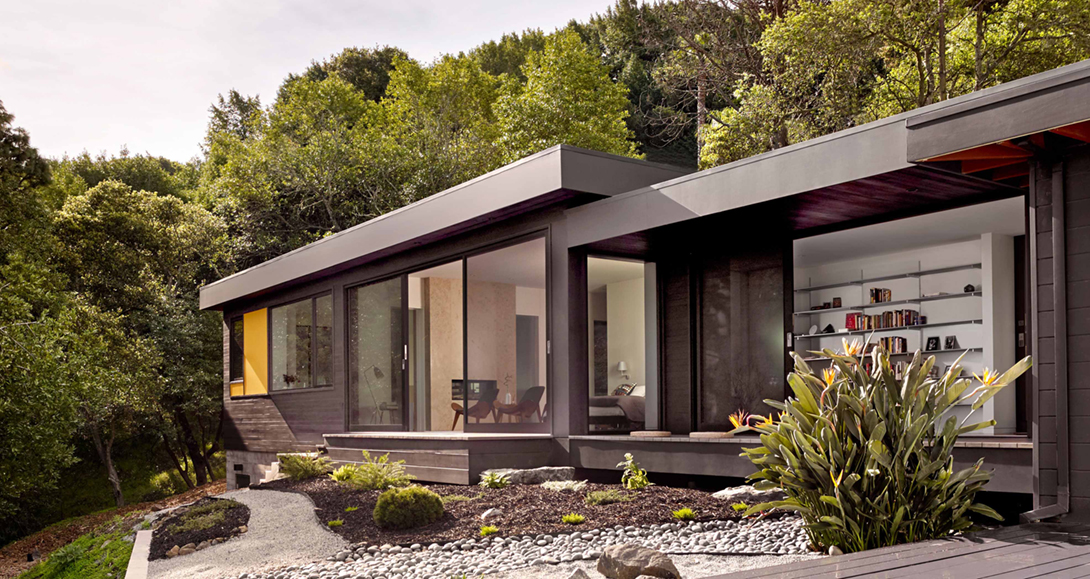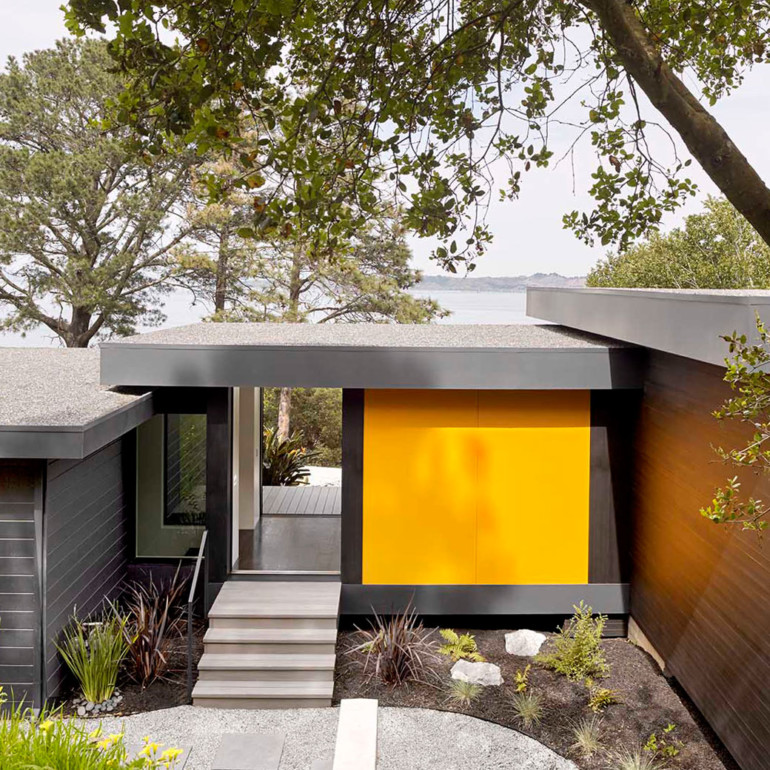AFTER SEVERAL YEARS IN OAKLAND, London-born Chris Porter, 49, and his wife Laura, a Texan Anglophile, wanted to live closer to nature. They explored Marin and eventually found their spot by chance while driving around Tiburon.
The roughly two-acre wooded north-facing hillside lot had expansive views of San Pablo Bay. “ That was it. That kind of peace and quiet so close to San Francisco was remarkable,” Chris says. The commuter ferry terminal was a bike ride away.
At first, the flat, rectilinear 2,300-square-foot midcentury-style house already on site for them and their dog Bella. Its kitchen had been updated and the house needed only small tweaks. They loved it and it was popular with friends and family visiting from afar.
The downside? It only had cheek-to-jowl bedrooms, and the couple began to dream of a private master suite. “We could see the bay from the living room but not from our bedroom. And even then, we couldn’t see trees and the valley except from outside on the deck,” Chris says. Perhaps, they thought, a new wing — or even a treehouse — away from the main house might provide a better view.


Chris, currently a materials specialist and senior director with Fitbit, used to work for a San Francisco industrial design firm in offices designed by architect Cary Bernstein. Their spare design had always reminded him of Japan where his father had been stationed in the Army.
He called Bernstein, a New York émigré in the Bay Area with a degree from Yale, and she was excited about helping. Her typical assignments — disciplined, modernist urban in ll projects — rarely provided the opportunity to “stretch your arms out and engage the landscape,” she says. Besides, her brother lives in Japan, and “we had this Japanese connection and shared a ryokan-style aesthetic,” Chris says.

Meanwhile, Laura, who is a choral singer for the San Francisco Symphony and a business manager for a San Francisco clothing boutique, wanted a luxurious bathroom facing the view.
Inexorably, the plans for a modest 500-square-foot addition ballooned to 1,100 square feet. And to get the kind of psychological distance but physical proximity they sought between the old and new wings, they chose an attened area west of the existing house, “and we decided to have a long bridge between the two,” Bernstein says.
The roughly L-shaped addition was to contain a large bedroom with ample storage and a double-sided replace shared with the adjacent bathroom, which would have a central tub, a walk-in shower, separate sinks and a continuous wall of operable doors facing the view. “It also occurred to me that we should add details — like locked storage and doors, to separate it all from the main house — that would allow us to rent the addition out sometimes to help pay for it,” Laura says.
Bernstein imagined a floating, cantilevered structure but, limited by budget, she just designed the 7-by 21-foot entry bridge between the wings to be two feet higher than the original doors, “to allow the landscape to ow underneath.”

Everyone was ready to proceed. But the ready-to-build site was not.The couple and Bernstein learned it had a history of landslides, so they needed to build a 50-foot-long, 6-foot-high retaining wall and then sink in some costly 8-foot-deep piers to secure the addition’s substantial concrete foundation to bedrock. And in case of forest fires, they had to include commercial-grade water pumps and sprinklers.
“It suddenly became an expensive landscape project,” Bernstein says with a sigh. “But when your geotechnical engineer recommends it, you have to listen.”
To mitigate costs, they abandoned the idea of decks cantilevered toward the view. On the bright side, the bridge — with facing front and back doors that open onto a 5.5-foot-wide deck — now doubles as a covered breezeway/deck. Stocked with books, it is also the de facto library, where Laura likes to sit and read when it rains and where Bella also finds refuge. Its operable doors all have screens because as much as she loves living in the woods, Laura is allergic to mosquitoes.
Using voids and passageways and working holistically with interiors and exteriors “is a Japanese thing to do,” Bernstein says. Similarly, she also opted to work on all design aspects, including the interiors of the new wing, “but houses are analogous to people,” she says. “ They have an outer life and an inner life, and they are not necessarily matched perfectly.”
Responding to the trees, water and landscape, Bernstein chose a wide palette of textured materials and colors. Outside, the old house is painted the deep blue of the water, and the new, narrower cedar siding is a dark brown Spanish gray color. Large MDO (medium-density overlay) panels inspired by Japanese shoji screens secrete a pocket door at the front entrance, but instead of a discreet white, they are painted a bright California poppy yellow. “White would have been too literally Japanese,” Bernstein says. “I am a minimalist, but not always in a black-and-white way.”
Inside, keeping the colors relatively neutral made sense, but Bernstein did play with contrasts and textures. The bedroom’s dark stained wood doors abut earthy gray large-format 4-by-4-foot matte porcelain door tiles in the bathroom, where 16-foot-wide vanities on each side have figured maple cabinetry. The pale wood alludes to the trees outside but also contrasts well with dark Caesarstone counters.The earth-toned fossil-embedded limestone for the replace, found after several visits to different stone yards, complements creamy large-format Brix tiles called “linen” by Japanese designer Naoto Fukasawa, on the bathroom walls. Their tofu linen-cloth texture also works well with the fickle blue/green of smaller Heath tiles in the shower that seem to change hues like the bay in the course of the day.
In the master bedroom, a large walk-in closet behind the bed has mirrored closets at each end. One of them contains a bar and refrigerator for renters; the other one holds Laura’s cashmere and wool things, sachets and lavender that can be locked away.
“We spend a lot of time in these rooms,” Laura says. “ is wing has become another living space.”
The spa-like bathroom is a big draw after a day of work, to soak in and even to have a glass of wine before a party. In the bedroom, the large picture window at the foot of the bed and the extraordinary quiet of the well-insulated space induce a meditative state. In the mornings, “we used to rise quickly to go into the main part of the house,” Laura recalls. “But now, we linger in bed with tea.”
Sometimes, a huge bay tree outside, populated with birds, rustles in the wind and, when it rains, seems to dance like a kinetic piece of art that deer and squirrels visit.
“I have never lived in such a space that always feels like you are on vacation,” Laura says. “On the deck outside, unless someone is in a boat in the water, no one can see us. We are completely alone.”

JAPANESE REDUX ARCHITECT
Cary Bernstein Architect, cbstudio. com
PRINCIPAL ARCHITECT
Cary Bernstein, AIA, LEED AP; PROJECT ARCHITECT Matthew De Mott, RA
GENERAL CONTRACTOR
Weitekamp Remodeling & Construction Inc., wremodeling.com
LIGHTING DESIGN
Illuminosa Inc., illuminosa. com
LANDSCAPE DESIGN CFLD
Landscape Design, cferrislandscape.com
BREEZEWAY/DECK
Rakks shelving, rakks.com; Fleetwood doors and screens, eetwoodusa.com.
MASTER BEDROOM
Table lamp by Design House Stockholm, danishdesignstore.com; Shell Chair by Hans Wegner from Carl Hansen, carlhansen.com; coffee table, Around by Thomas Bentzen, from Muuto, muuto.com; Candice Olson rug, from Surya Rugs Sculpture Collection, surya.com; Grasshopper door lamp, by Greta Grossman, from Gubi, gubi.com.
MASTER BATHROOM
Custom cabinets by Cary Bernstein Architect, built by Precision Cabinets, precisioncabinets.com; Nokori bathtub by Bain Ultra, from Bain Ultra, bainultra.com; Custom Platner Stool from France & Son, franceandson.com; bathtub xtures, by Grohe Essence New, from Grohe USA, grohe.us.com; wall tile (blue), Field from Heath Ceramics, heathceramics.com; wall tile (beige), Brix Linen by Naoto Fukasawa, from Luminaire, luminaire.com; fooring, by Patricia Urquiola Dechirer for Mutina, from Stone Source, stonesource.com; sconces, Tight Light by Piero Lissoni, from Flos, usa. os. com; replace from Marquis Fireplaces, marquis replaces.net.
Photos by Cesar Rubio
This article originally appeared in SPACES print edition with the headline: “Japanese Redux”.

Zahid Sardar brings an extensive range of design interests and keen knowledge of Bay Area design culture to SPACES magazine. He is a San Francisco editor, curator and author specializing in global architecture, interiors, landscape and industrial design. His work has appeared in numerous design publications as well as the San Francisco Chronicle for which he served as an influential design editor for 22 years. Sardar serves on the San Francisco Decorator Showcase design advisory board.




